4.4: Sculpture
- Page ID
- 156872
Overview
Three-dimensional works of art: Have height, width, and depth. A two-dimensional object is a shape; a three-dimensional object is called a form.
Venus of Willendorf
Sculpture is any artwork made by the manipulation of materials resulting in a three-dimensional object. The sculpted figure of the Venus of Berekhat Ram, discovered in the Middle East in 1981, dates to 230,000 years BCE. It is the oldest example of artwork known. The crudely carved stone figure will fit in the palm of your hand. Its name derives from the similarity in form with so-called female fertility figures found throughout Europe, some of which date to 25,000 years ago. For example, the form of the Venus of Willendorf below shows remarkable skill in its carving, including arms draped over exaggerated breasts, an extended abdomen and elaborate patterning on the head, indicating either a braided hairstyle or type of woven cap. Just as remarkable, the figure has no facial detail to indicate identity. The meaning behind these figures is difficult to put into context because of the lack of any written record about them or other supporting materials.
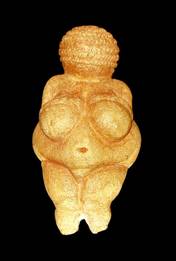
Venus of Willendorf, c.25,000 BCE. Natural History Museum, Vienna. Image in the public domain
Approaches to Three Dimensions in Sculpture
Freestanding or Sculpture in the Round
- Sculpture can be freestanding or sculpture in the round, where the viewer can walk completely around the work to see it from all sides.
- The Rape of a Sabine by Giambologna is a freestanding sculpture is designed to be seen from all sides.
- It forms a spiral that draws the viewer around its changing planes.
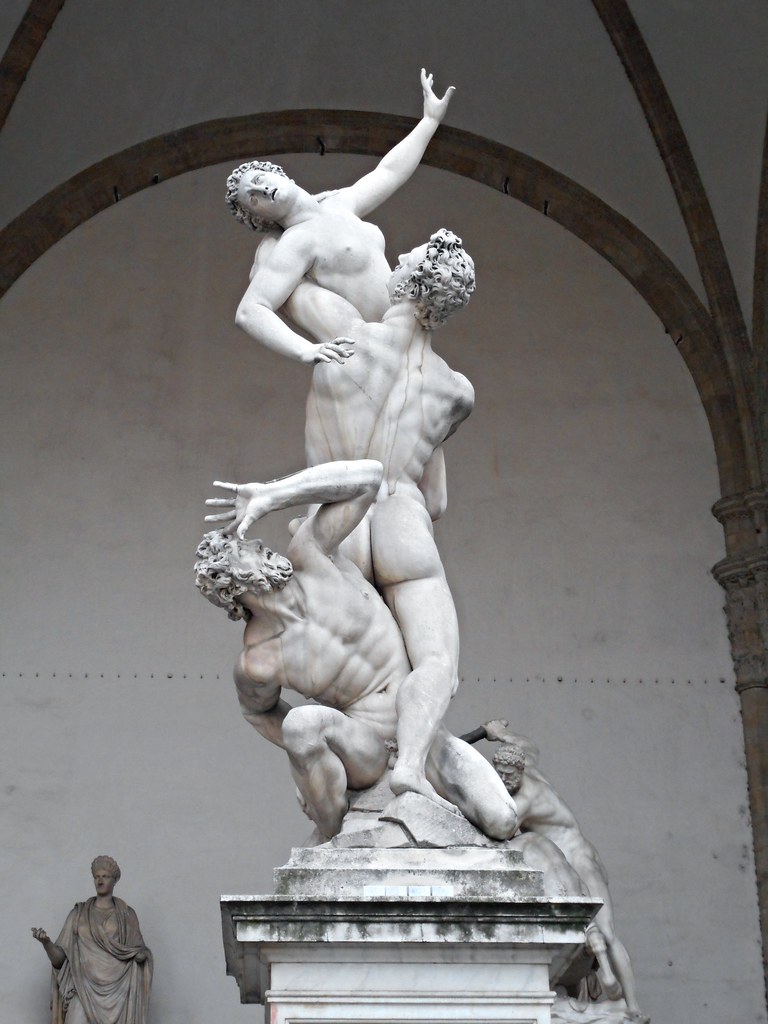
Giambologna, Rape of a Sabine, 1582. Gesso, height 13’8”. Galleria dell’Accademia, Florence, Italy. "'Abduction of the Sabine women' (1583) by Giambologna (Jean de Boulogne, Douai 1529-Florence 1608) - Loggia della Signoria in Florence" by Carlo Raso is marked with Public Domain Mark 1.0.
Relief, Bas-Relief, High Relief
- Sculptures can be created in relief, where the primary form’s surface is raised above the surrounding material, such as the image on a coin.
- Dying Lioness relief was found in the North Palace of King Ashurbanipal in Mesopotamia.
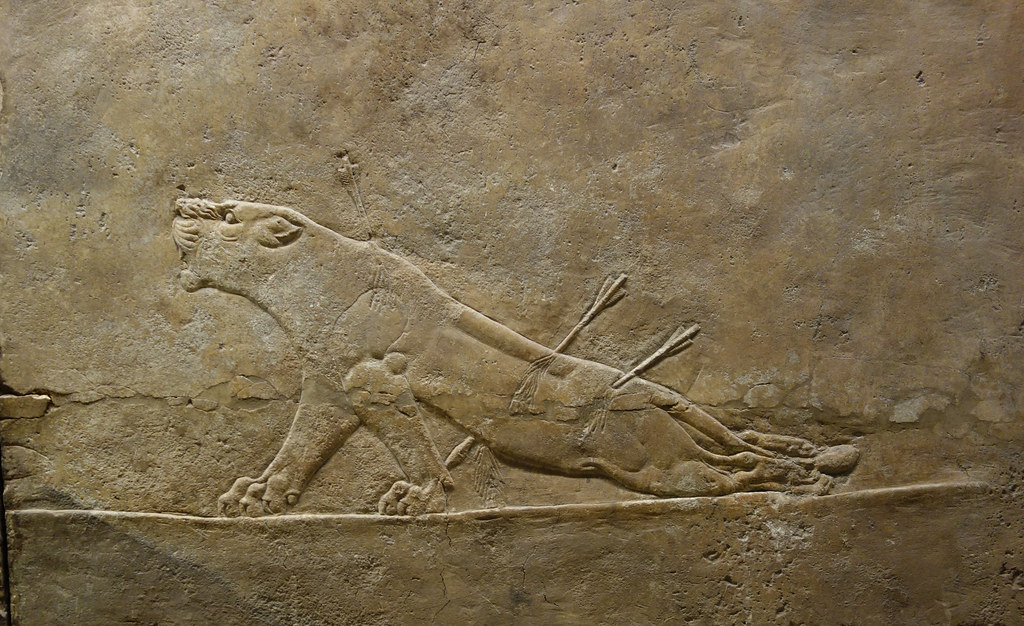
Dying Lioness, limestone relief from the North Palace of Ashurbanipal, Nineveh, Assyrian period, c. 650 BCE. British Museum, London, England. "Lion Hunts of Ashurbanipal, dying lioness" by profzucker is licensed under CC BY-NC-SA 2.0.
- Bas-relief (bas means “low” in French) refers to a shallow extension of the image from its surroundings
- High relief is where the most prominent elements of the composition are undercut and rendered in more than half in the round against the background.
- Rich, animated bas-relief sculpture exists at the Banteay Srei temple near Angor Wat, Cambodia. Here humans and mythic figures combine in depictions from ancient Hindu stories.
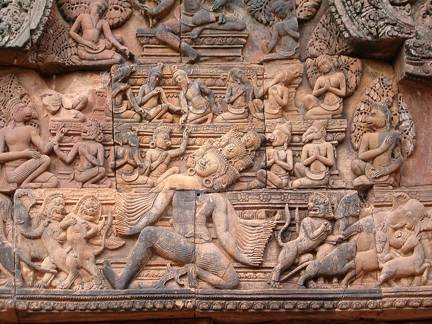
Bas-relief sculpture at the temple Banteay Srei, Angor, Cambodia. Tenth century. Sandstone. Image in the public domain.
Methods of Sculpture
- Subtractive
- Additive
Subtractive
A sculptor uses a tool to carve, drill, chisel, chip, whittle, or saw away unwanted material.
Carving
- The most ancient works of art that still exist were made using subtractive methods
- Most were made of stone or ivory
- Worked by chipping, carving, sanding, and polishing
- Mt. Rushmore is one of largest and most famous sculpted portraits
- Borglum searched for a mountain with the right kind of carving stone
- Mostly carved by miners using dynamite
- It shows the image of four US Presidents
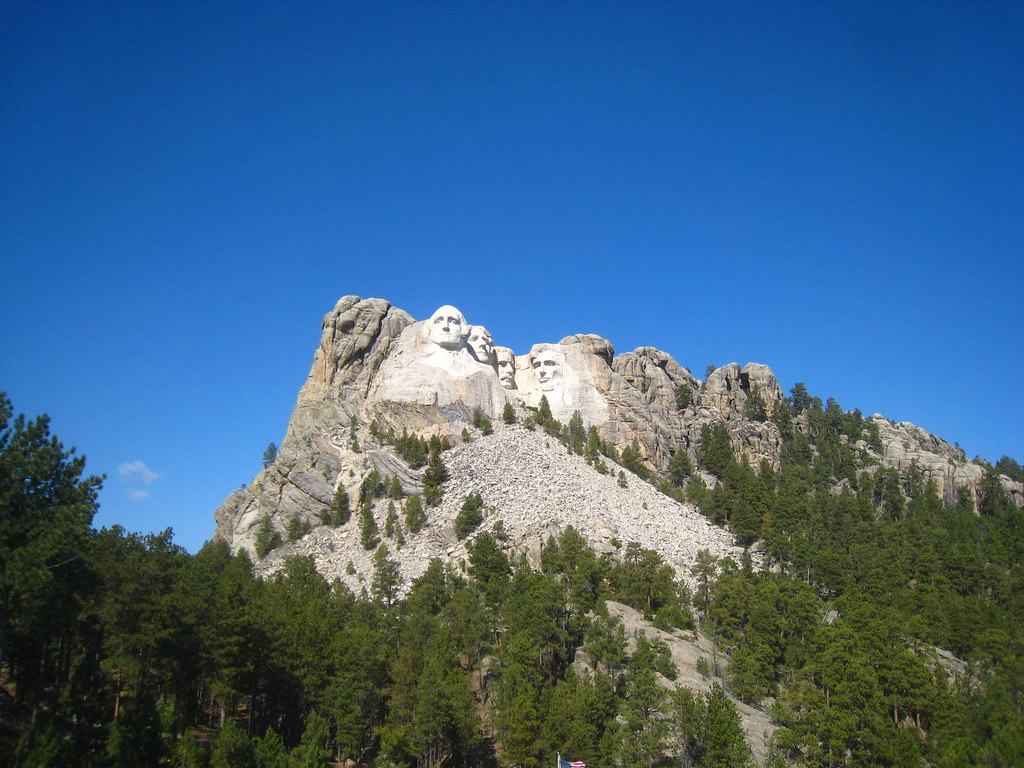
"Mt Rushmore" by cm195902 is licensed under CC BY 2.0.
Additive
Additive is processes of modeling, casting, or constructing in which sculptors add material to make the final artwork
Modeling
- Modeling is an additive process; the artist builds up the work by adding material
- Clay or wax is in this category.
- In March 1974, a group of peasants digging a well in drought-parched Shaanxi province in northwest China unearthed fragments of a clay figure—the first evidence of what would turn out to be one of the greatest archaeological discovery of modern times.2
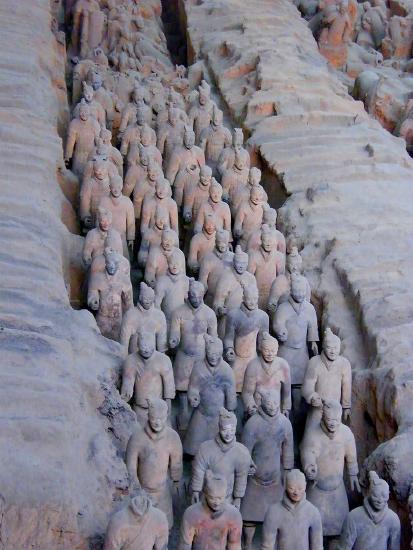
The 1974 discovery of buried vaults at Xi'an filled with thousands of terra cotta (Terra-cotta is baked clay) warriors stunned the world. O. Louis Mazzatenta / NGS Image Collection. "Terra Cotta Soldiers" by Stanley Zimny is licensed under CC BY-NC 2.0.
Casting
- This process involves adding a liquid or pliable material to a mold
- First, a model of the final sculpture is made; this is used to make a mold into which a casting liquid is poured
- When it hardens, the result is a detailed replica of the original model 1
- Donatello’s landmark work – and one of the greatest sculptural works of the early Renaissance – was his bronze statue of David. This work signals the return of the nude sculpture in the round figure, and because it was the first such work like this in over a thousand years, it is one of the most important works in the history of western art. 3
- For further information; Read Donatello, David, by DR. HEATHER GRAHAM
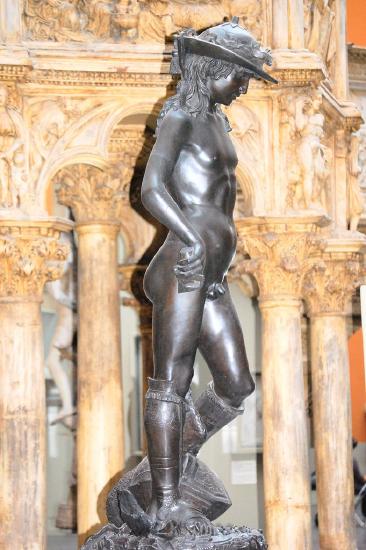
Donatello, David, c. 1440-1460, bronze. "Donatello's David - plaster replica, V&A, right" by ketrin1407 is licensed under CC BY 2.0.
Other Mediums of Sculpture
Earthworks, assemblage, ready-mades, kinetic sculptures, and installation
Earthworks
- This type of art uses the surface of the Earth as material
- The best-known modern earthwork is Robert Smithson’s (1938–1973) Spiral Jetty in the Great Salt Lake in Utah
- The coiled artwork was made using 6,550 tons of rock and dirt, sourced from dump trucks, to pave a spiraling roadbed out into the salt lake
- The artwork drowns and then rises with a new encrustation of salt crystals 1
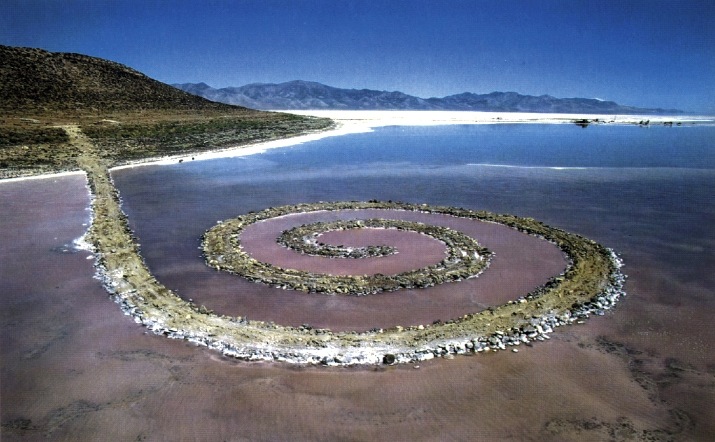
Robert Smithson, Spiral Jetty, 1970 (Great Salt Lake, Utah) (photo: Gianfranco Gorgoni) ©Holt-Smithson Foundation
Assemblage
- A three-dimensional work of art made from combinations of materials including found objects or non-traditional art materials.4
- To create this sculpture, Nevelson stacked boxes against a wall and filled each compartment with found wooden scraps including moldings, dowels, spindles, and furniture parts. She then covered the entire assemblage with black paint, both unifying the composition and obscuring the individual objects. She once explained her fascination with the color black: "It wasn't a negation of color. It was an acceptance. Because black encompasses all colors." The towering geometric construction plays with flatness and recession, straight lines and curves, overlaps and vacancies. 5
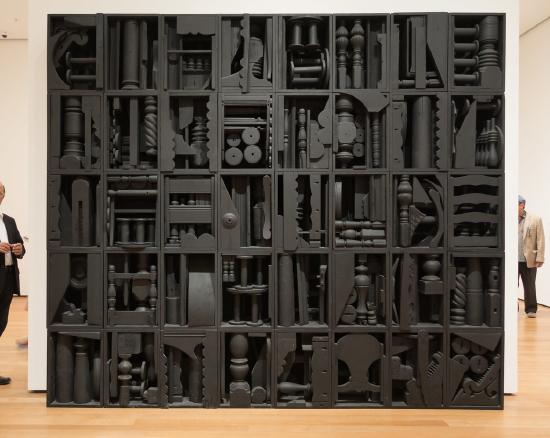
Louise Nevelson, Big Black (1963). "Louise Nevelson, Big Black (1963)" by smallcurio is licensed under CC BY 2.0.
Readymades
- The term readymade was first used by French artist Marcel Duchamp to describe the works of art he made from manufactured objects. It has since often been applied more generally to artworks by other artists made in this way 6
- There are three rules for readymade artworks; 1-The choice of object is itself a creative act. 2-By canceling the ‘useful’ function of an object, it becomes art. 3-The presentation and the addition of a title to the object have given it ‘a new thought’, a new meaning. 6
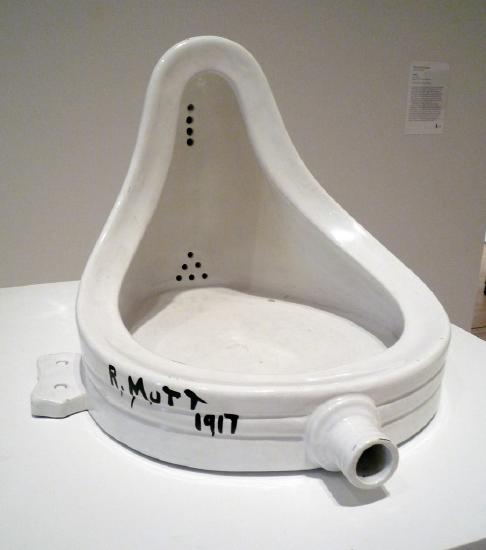
Marcel Duchamp, Fountain, 1917. "Marcel Duchamp, Fountain" by profzucker is licensed under CC BY-NC-SA 2.0.
Kinetic Sculpture
- Sculpture that moves is called kinetic sculpture
- Alexander Calder's monumental mobile moves solely on the air currents in the National Gallery of Art East Building's Central Court. The sculptor originally intended the work to have a motor, but the use of advanced, lightweight materials made this unnecessary. 7
- For more information "WHO IS ALEXANDER CALDER?" by Tate Museum.
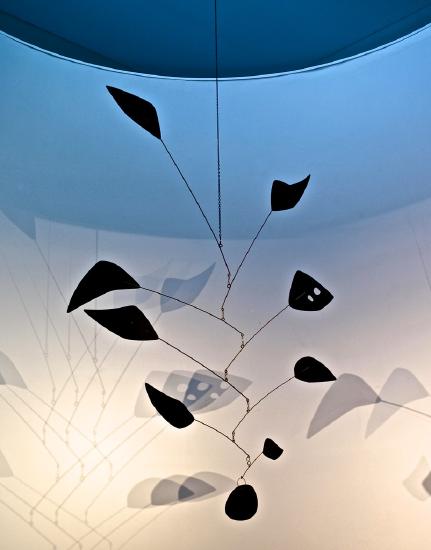
"Black Spray (1956) - Alexander Calder (1898 - 1976)" by pedrosimoes7 is licensed under CC BY 2.0.
Installation Art
Installation art utilizes multiple objects, often from various mediums, and takes up entire spaces. It can be generic or site-specific. Because of their relative complexity, installations can address aesthetic and narrative ideas on a larger scale than traditional sculpture. Its genesis can be traced to the Dada movement, ascendant after World War I and which predicated a new aesthetic by its unconventional nature and ridicule of established tastes and styles. Sculpture came off the pedestal and began to transform entire rooms into works of art. With installation art, the viewer is surrounded by and can become part of the work itself.
Dan Flavin
- Dan Flavin is one of the first artists to explore the possibilities of light as a sculptural medium.
- Since the 1960s his work has incorporated fluorescent bulbs of different colors and in various arrangements.
- Moreover, he takes advantage of the wall space the light is projected onto, literally blurring the line between traditional sculpture and the more complex medium of installation.

Dan Flavin, untitled, 1970. Installation view, David Zwirner, Paris, 2019. "dan flavin" by Dean Hochman is licensed under CC BY 2.0.
Sarah Sze
- Sarah Sze is an American artist widely recognized for challenging the boundaries of painting, installation, and architecture.
- Sze's sculptural practice ranges from slight gestures discovered in hidden spaces to expansive installations that scale walls and colonize architectures.
- Triple Point (Pendulum) was first exhibited at the 55th Venice Biennale, where Sze represented the United States
in 2013. The title is borrowed from the term “the triple point of water,” a reference to the state at which water can
coexist simultaneously in three forms: steam, ice, and liquid. Gathering the objects from the world around us, Sze creates a sculpture in a state of flux, hovering between many forms at once. 10 - Sarah Sze's Triple Point (Pendulum). 2013 at MoMA
Rachel Whiteread
- British artist Rachel Whiteread’s installation Embankment from 2005 fills an entire exhibition hall with casts made from various sized boxes.
- At first appearance a snowy mountain landscape navigated by the viewer is actually a gigantic nod to the idea of boxes as receptacles of memory towering above and stacked around them, squeezing them towards the center of the room.

Rachel Whiteread, Embankment, 2005. Source: Wikipedia, licensed through Creative Commons
Olafur Eliasson
- Olafur Eliasson (Icelandic: Ólafur Elíasson; born 5 February 1967) is an Icelandic–Danish artist known for sculptured and large-scale installation art employing elemental materials such as light, water, and air temperature to enhance the viewer's experience.

Light Installations / Art about global warming, Art created in 2003, Art in London, community, Light and Space, Olafur Eliasson, Tate Modern, Turbine Hall
Sources
- Debra J. DeWitte, Ralph M. Larmann, and M. Kathryn Shields. Gateways to Art: Understanding the Visual Arts, Third Edition. 2018
- Lubow, Arthur. Terra Cotta Soldiers on the March. A traveling exhibition of China’s terra cotta warriors sheds new light on the ruler whose tomb they guarded. https://www.smithsonianmag.com/histo...arch-30942673/
- ItalianRenaissance.org, "Donatello’s David," in ItalianRenaissance.org, June 28, 2012, http://www.italianrenaissance.org/donatellos-david/.
- Modern Art Museum. www.moma.org/collection/terms/assemblage
- Modern Art Museum. www.moma.org/collection/works/81177
- Tate Museum. https://www.tate.org.uk/art/art-terms/r/readymade
- National Gallery of Art. https://www.nga.gov/collection/art-o...age.56517.html
- Tate Museum. https://www.tate.org.uk/art/art-term...stallation-art
- Tate Museum. https://www.tate.org.uk/art/artworks...ubi-xix-t00891
- Modern Art Museum. www.moma.org/collection/works/177636?

